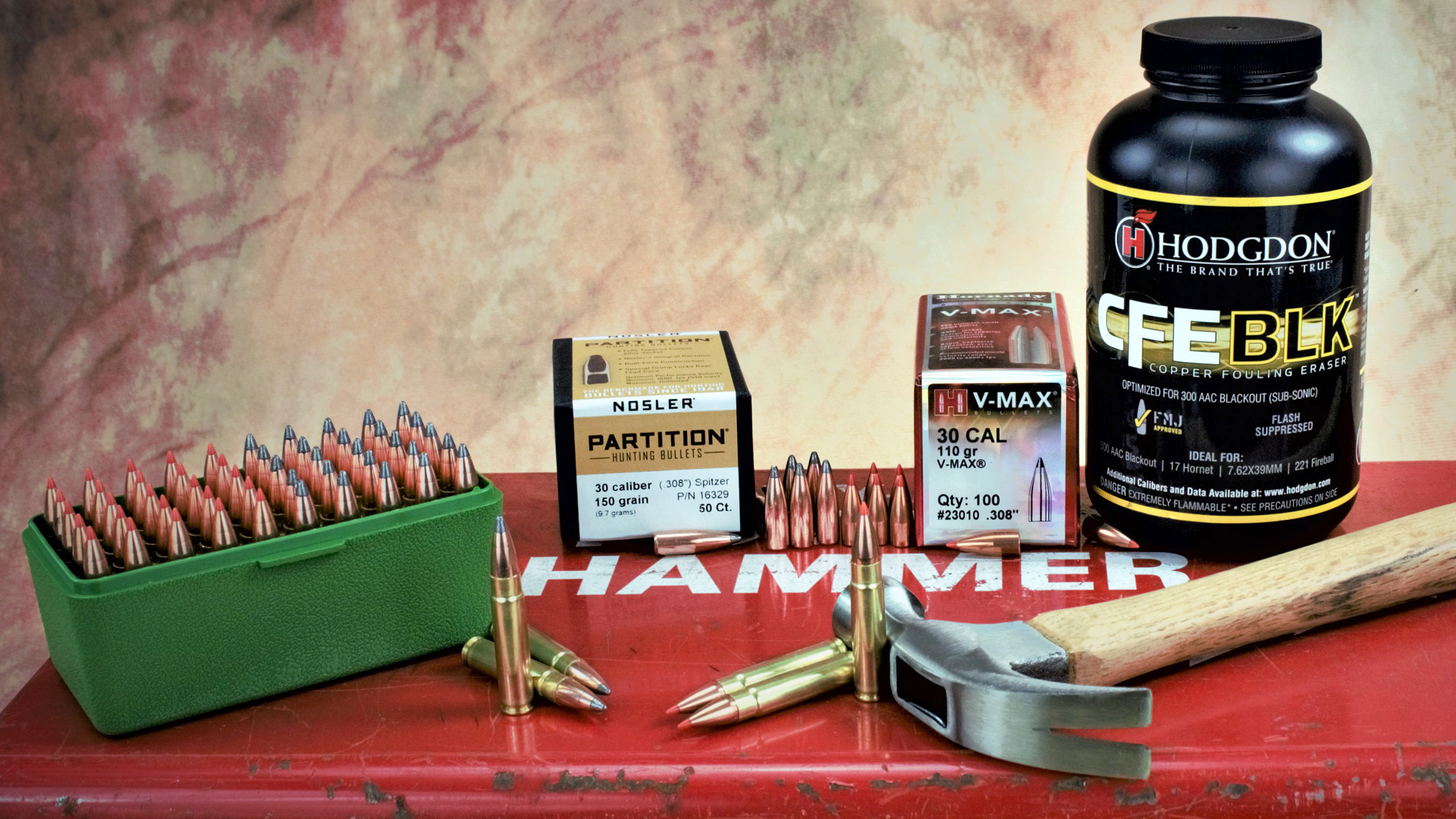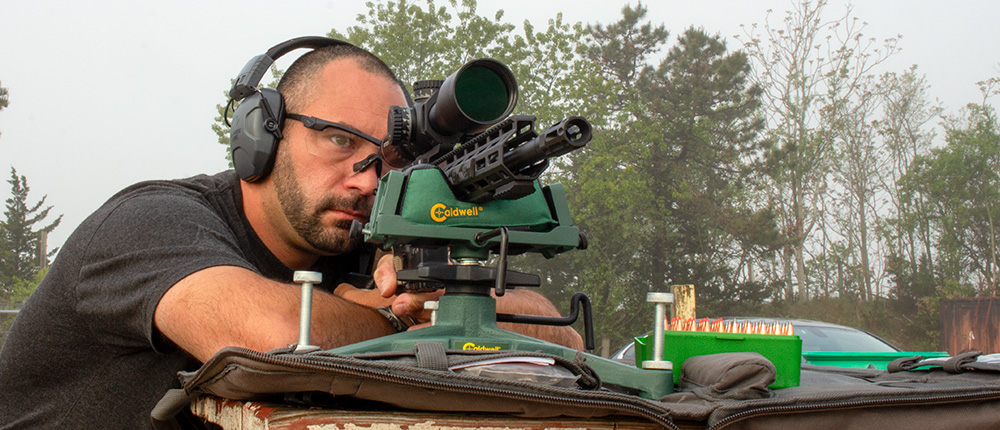
America has been fascinated with the .30-cal. bullet ever since it was introduced into military service, and rightfully so. Cartridges have been created with these now-common projectiles that have won wars, clenched shooting titles and put meat on tables for more than a century. Building the ideal .30-cal. cartridge for the AR-15 was a natural step in firearm development, yet it was one that met with substantial resistance.
Early attempts began with the Russian 7.62x39 mm cartridge, as it could easily be fitted within the dimensions of the platform’s magazine, but alas, its sharply tapered case caused early feeding problems, and it never completely recovered from the unreliability stigma. The advent of the .300 Blackout would come to center stage and produce exceptional results when loaded to subsonic velocities. However, as it was built primarily to operate in subsonic form, the Blackout trails off, performance-wise, when pushed beyond the sound barrier.
Dissatisfied with both cartridges (and others), prolific firearm and ammunition designer Bill Wilson set out to wring as much downrange energy as possible from the AR-15 through a dedicated supersonic .30-cal. cartridge. Years of testing and development would bear fruit in the form of the .300 HAM’R, and it would gain SAAMI acceptance in January 2020. The case of the .300 HAM’R is nearly 1/4" longer than that of the .300 Blackout, which leaves enough room to produce .30-30 Win. energy levels out of the famed black rifle.

While the author, like most handloaders, is never fully satisfied with his recipes, he nonetheless was able to get respectable accuracy out of his two resulting loads, which are catered toward the .300 HAM’R’s twin core competencies of medium-game and varmint hunting. Photo courtesy of author.
Arguably, with the right combination of components, one could even start to approach .308 Win. performance out of a much smaller platform, and that prospect alone was enough to get me interested in experimenting with it. So, gun in hand, I set out to build two loads that would cover all possible bases for Wilson’s ultimate .30-cal. AR-15 chambering.
As I am fortunate enough to have a direct pipeline to Mr. Wilson himself, I decided to start the process with a bit of fact-finding to understand the cartridge better. Throughout a few emails, Bill informed me that there are really only three powders that work well when loading the .300 HAM’R, and they are Hodgdon CFE BLK, Shooters World SOCOM and Accurate #1680. While working with the rarer powders has a certain mystique to it, I decided to go with CFE BLK because, well, I had some on the shelf.
Like most handloaders, I am dealing with the same component shortages as the rest of the community. Moreover, holding off any longer than necessary to put together a project is not conducive to a writing career. Luckily, this was also Wilson’s preferred powder, so things were coming up roses. In our closing emails, I inquired about building something that would perform at subsonic velocities. At the time of this writing, I was informed that there isn’t a powder and bullet combination that can reliably cycle the action while remaining below the speed of sound.
I selected Hornady 110-grain V-Max and Nosler 150-grain Partition bullets to touch both ends of the weight spectrum that this cartridge can handle. These bullets represent two of the best uses for this chambering—medium-game and varmint hunting. Furthermore, both projectiles are known performers on whitetail deer as well as coyotes. When chambered in .300 HAM’R, the AR-15 is a multi-faceted game-getter.
I had a few options for dies but decided to go with a set of Hornady Custom grades, as these were recently released. Whenever these dies are an option, I tend to gravitate toward them because they get the job done at a price that doesn’t make me question if it’s even worth reloading for a particular cartridge. Lastly, cases were available from Starline that take a typical small rifle magnum primer, the one thing I have in abundance.
My go-to primers for medium-to-high-pressure cartridges have always been CCI, something I determined during 6.5 mm Grendel reloading experiments. I have found that they could handle powder charge/bullet combinations that would pierce some other brands with softer cups. It’s also hard to argue with their unparalleled consistency, so a CCI man I am.

(l.) With a cartridge case nearly 1/4" longer than that of the .300 Blackout, the .300 HAM’R allows for greater propellant capacity—and a gentle tapping of the case helps even heavier charges settle into place. (Ctr.) Standing side-by-side, .223 Rem., .300 Blackout and .300 HAM’R (l. to r.) illustrate each cartridge’s relative case size and overall length (r.). The author’s .300 HAM’R loads (far r.)—one with the 110-grain Hornady V-Max and one with the 150-grain Nosler Partition (l. to r.)—produced groups on target that would qualify them for personal defense and hunting. Photos courtesy of author.
With component acquisition complete, I sized brass as I waited for my RCBS MatchMaster to warm up in order to throw my charges. Although the spherical nature of CFE BLK allows it to flow through a measure almost as if it were liquid, I opted to use this dispenser because plugging in a number to make just five rounds is far faster than adjusting a baffle to hit a 0.1-grain sweet spot.
After inspecting my first charge, I got a little nervous as things looked slightly off. While CFE BLK is billed as a ball powder, it contains a few flattened kernels that approach a flake-like nature. My first thought was that I didn’t clean out the machine thoroughly enough the last time I used it and contaminated my powder with an amount of Unique or another fast-burning powder.
After inspecting another lot, however, I realized this was not the case. CFE BLK does contain a copper-reducing additive, so part of me wonders if that is what I was seeing, but I digress. Regardless of how experienced you are as a handloader, never think yourself above making a simple mistake, as we are all human. I’ve heard enough stories of destroyed guns, or worse, to be skeptical whenever something looks out of sorts.
Moving on to bullet seating, I first confirmed that the 26.5-grain charge I just dispensed was indeed the minimum for a 110-grain payload and poured it into my first case. Interestingly, this charge filled the case well into the neck area, which was both reassuring and concerning at the same time—although a full case is something that I strive for when selecting a propellant, it’s not desirable right off the bat. Generally speaking, I like hitting this mark at somewhere around three-quarters of the maximum powder charge.

(l.) When working up a .300 HAM’R load, Hodgdon CFE BLK is the preferred propellant of both the author and Wilson Combat’s Bill Wilson. The author found it to meter well and allow for more-than-adequate charges within the Starline cases he used. Hornady’s economical custom-grade die sets (l. ctr.) work well and encourage loading for new chamberings. The company’s V-Max 110-grain bullets (r. ctr.) and Nosler’s 150-grain Partitions (r.) stand at either end of the weight spectrum for .300 HAM’R. Photos courtesy of author.
With some gentle tapping, I got several other charges into their respective cases and made it to 28.5 grains, which was about one grain shy of max. I decided to seat the bullets as far out as possible, to a length of 2.260", in an effort to reduce the powder compression; but, except for the lowest charges, I doubt it was successful. The same relationship held true with the lighter powder charges and the longer 150-grain Nosler Partition bullets. Starting at 23.0 grains, I was able to seat bullets with up to 24.5 grains of powder before beginning to feel the squeeze.
 Testing these loads consisted of the usual preferred equipment and a good, sturdy, benchrest shooting position. Starting with the 110-grain V-Max load, I experienced perfect cycling and sub-m.o.a. accuracy, leaving me very little room for improvement. In fact, it was all downhill from there, as both group size and standard deviation showed great inconsistencies. As the minimum charge still yielded 1,394 ft.-lbs. of energy, I wasn’t all that concerned with chasing velocity in exchange for accuracy.
Testing these loads consisted of the usual preferred equipment and a good, sturdy, benchrest shooting position. Starting with the 110-grain V-Max load, I experienced perfect cycling and sub-m.o.a. accuracy, leaving me very little room for improvement. In fact, it was all downhill from there, as both group size and standard deviation showed great inconsistencies. As the minimum charge still yielded 1,394 ft.-lbs. of energy, I wasn’t all that concerned with chasing velocity in exchange for accuracy.
I experienced the same scenario with the 150-grain Partition loads, except standard deviations were excellent across the board. I always get a chuckle when this happens because it boldly illustrates how ineffective this value alone is at determining quality ammunition, particularly in rounds that will not be used at extended range. Nonetheless, I was able to pull together a group that was slightly larger than 2 m.o.a., which is well within “minute of hog” at the short ranges at which they are engaged. I also concluded that the 1,374 ft.-lbs. of muzzle energy that this load created was more than enough to bring home the bacon. Above all, everything cycled well and was an absolute joy to shoot, so nothing precludes the handloader from taking either load to the range just to bang steel and enjoy an AR-15 with an exotic chambering.
So, am I satisfied? Well, if you handload, then you know that the answer is never yes. If this were a rifle that I planned to compete with, I might consider testing some other components or powder charges. However, this cartridge and this upper were never intended to cut X-rings in a match setting. But, like the tool it was named after, the .300 HAM’R is a utilitarian piece of kit, and these groups are certainly small enough for its intended use. Then again, reaching sub-m.o.a. performance in the case of the V-Max certainly isn’t something to sneeze at, particularly in what is essentially a hunting rifle.
Additionally, I would be very interested to test these loads in a barrel that uses the faster 1:13" twist rate, as that might pull things in tighter and open load data up to heavier bullets. In the meantime, I would have no reservation about taking either load on a hog hunt or through the densely packed deer woods of the northeast. Thirty-caliber bullets always instill confidence in an ethical harvest, and thanks to men like Bill Wilson, we can reliably drive these through the compact and maneuverable AR-15 platform.




































